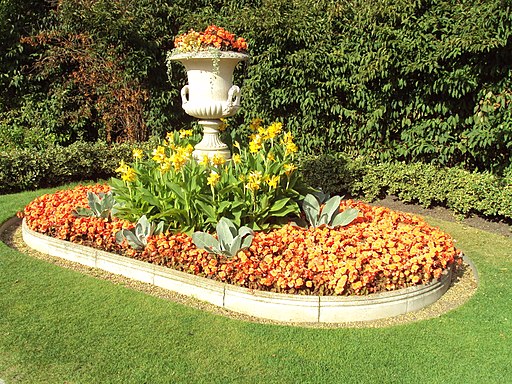On Edging

Garden vase, flower beds, and stone edgings in the Avenue Gardens, Regent’s Park, London, in July 2010. Photo by Rept0n1x.
Roger Cook of This Old House gives an overview of the easier ways to edge.
The durability of such edging can be increased by resorting to some of the shovel work and use of drainage rock or sand that is the method for standard paver installation. Without a drainage base under the concrete, no-dig edging, and paver blocks, there will inevitably be some cracking of the concrete and consequent heaving of the materials. As mentioned earlier, however, this type of installation is a compromise between all of the elements of an edging job, and is particularly intended to cut down on back breaking shovel work and cost of additional materials. The best way to ensure the eventual frost heaving does not render the edging completely useless and unattractive is to deploy paver blocks that are as large and as heavy as possible without themselves being back breaking.
No-dig gardening is a method that has been gaining adherents for over a half century now, and it makes sense for gardeners interested in saving themselves some labor and possible injury to apply the same method elsewhere when possible, such as in edging garden beds. The simplest method of edging, and certainly the cheapest, requires digging an edge straight down three or four inches into the lawn, and then shaving that edge back in a slope toward the garden bed. This presents an attractive edge for a few months, but grass and weeds from the lawn inevitably infiltrate the bed, muddying the clean line of the edge, with the result that the gardener has to renew a cut edge at least once a year to keep it looking its best. That is obviously the opposite of no-dig gardening.
Mark Powers of This Old House demonstrates the full on labor and expense method of edging a garden bed. The editing makes the job look easier than it is, and while the edge looks great, this method is only for the most dedicated gardener.
A gardener who is healthy and strong and unafraid of hard work can certainly install a beautiful and durable garden bed edge and stand back to admire it as a job well done when it’s finished. The extensive materials required for a really top notch installation may cost quite a lot, but since the goal is lifetime durability, then the cost is a one time expense. For the gardener who may not be entirely healthy, or very strong, or interested in expending enormous energy in the garden, there are easier and cheaper edging alternatives, but such a gardener should beware foolishly wasting money and time on some of them advertised as cheap and easy.
— Izzy


Pause from Work, a road sign diagram posted to Pixabay with the Portuguese caption Pausa no Trabalho.



